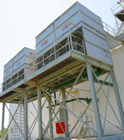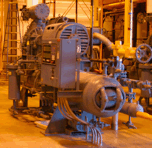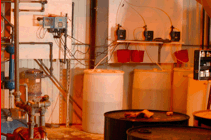|
|
|
Cooling Water Basics
|
 Cooling waters are used to transfer heat, by removing heat from an application and evaporating it to the atmosphere at the Cooling Tower. We find applications in buildings (commercial, office, nursing homes, hospitals, etc.), which are referred to as HVAC systems (Heating, Ventilation and Air Conditioning) and in process/manufacturing applications (compressor cooling, injection molding machines, etc.).
Cooling waters are used to transfer heat, by removing heat from an application and evaporating it to the atmosphere at the Cooling Tower. We find applications in buildings (commercial, office, nursing homes, hospitals, etc.), which are referred to as HVAC systems (Heating, Ventilation and Air Conditioning) and in process/manufacturing applications (compressor cooling, injection molding machines, etc.).
Cooling towers provide the means to allow heat to be removed from the water. With Water Cooled systems there are typically 3 main components:
Evaporator: This part of the system typically compresses a gas to allow that gas to transfer heat from one part of the system to another and does not require water treatment.
Chilled Loop: This part of the system picks up heat at a source (i.e. air handler for incoming air into a building), and transfers that heat via the Evaporator to the Open Loop.
Open Loop: This part of the system is open to the atmosphere; and utilizes a Cooling Tower. Heat is transferred outside the building, back into the atmosphere.
The most critical part of the system to treat is the Open Loop. Water flows over the cooling tower fill, providing for greater surface area for air passing through the water via the Tower Fan to absorb heat from the water and exhaust it out of the tower. As water is being constantly lost by evaporation, these systems require high amounts of make-up to remain in balance.
In the Open Loop, there are 4 significant problem areas:
- Scale: Because water is continually being lost by evaporation, fresh water has to be added. With this water come certain impurities; hardness, alkalinity, silica, etc.. As the water is evaporated, impurities stay behind, increasing the potential for the system to begin forming scale (deposits).
- Corrosion: Wherever we have water and metal there is going to be corrosion, which needs to be minimized.
- Fouling: This is the effect of airborne contaminants (airborne dust, dirt, leaves, bird-droppings, cottonwood, etc.). These can plug strainers and provide a nutrient source for microbiological problems.
- Microbiological Contaminants: Algae growths are common these systems, and must be controlled. The other microbes can include; algae, fungi, yeasts, molds, and bacteria, all of which can contribute to fouling. A layer of microbiological growths (dead or alive), can cause corrosion, lead to increased scaling, and become a nucleation point/trap for foulants. That layer can cause excessive energy consumption as film builds on heat exchange components. (A microbial film of 1/64" can cause a 30% increase in energy use/electrical demand.)
Water in the open/recirculating loop is usually made up/replaced with city water (or surface or well water). The amount of make-up required is the sum of the water evaporated (system load), plus the blowdown (forcibly displaced from the system as it has become highly concentrated with impurities). (Bleed-off and blowdown are synonymous). The need for blowdown can be illustrated with the following example:
 This process is what is happening in the cooling tower. Water is constantly being lost to evaporation (load), leaving behind the solids that came with it and were left by previously evaporated make-up water. We can use chemicals to alter the solubility of some of the impurities in the water, but at some point we are going to risk developing deposits if we don't control the amount of solids in the system via blowdown. This process is what is happening in the cooling tower. Water is constantly being lost to evaporation (load), leaving behind the solids that came with it and were left by previously evaporated make-up water. We can use chemicals to alter the solubility of some of the impurities in the water, but at some point we are going to risk developing deposits if we don't control the amount of solids in the system via blowdown.
For most systems, best balance of water re-use and solids concentration can be found at 3 to 4 concentrations (cycles of concentration). This is easily measured with a conductivity meter in the following relationship:

Many systems utilize automatic bleed-off/blowdown controllers, which allow the operator to set the bleed-of set point (2000, above example), which controls a solenoid to allow concentrated tower water to be discharged to the drain. A built-in differential control automatically senses when the concentrated water's conductivity is lowered by 150-200 mMHOS.
Treatment Programs
 Scale & Corrosion Inhibitors: If the concentrated tower water is less than 200 ppm of Total Alkalinity, the water is considered to be corrosive and ServeTech will utilize a product designed for corrosive waters. If the concentrated water has more than 200 ppm Total Alkalinity, ServeTech will utilize a product designed to manage scale-forming waters. Scale & Corrosion Inhibitors: If the concentrated tower water is less than 200 ppm of Total Alkalinity, the water is considered to be corrosive and ServeTech will utilize a product designed for corrosive waters. If the concentrated water has more than 200 ppm Total Alkalinity, ServeTech will utilize a product designed to manage scale-forming waters.
To determine what your water will be is a matter of testing the make-up water for Total Alkalinity, then multiplying it by 3 (the number of cycles you expect) to determine what the total Alkalinity of the concentrated tower water will be.
Example:
City Water Total Alkalinity = 80 ppm
Expected Tower Water Total Alkalinity = (80x3) = 240ppm
Product of choice = ServeTech 2301-S
Proper feed of the selected, combined with cycles properly controlled at 3 to 4 will provide scale prevention, corrosion minimization and fouling control.
Microbiological Control: Microbes grow in all water sources, including cooling towers and open recirculating systems. To keep these under control, add a biocide, either automatically (recommended) or manually. Remember that even if the system isnŐt running on a regular basis, microbes will continue to grow. Therefore, biocides need to be added at regular intervals, whenever there is water in the open recirculating system. During warmer weather and/or under heavier loads, biocides should be added on a more frequent basis.
Automatic addition two different, alternating biocides, will ensure better control of micro-organisms. An oxidizing biocide, (like Bromine, calcium hypochlorite, etc.) is recommended to control algae and other micro-organisms. Alternating with a second non-oxidizing biocide, (DBNPA) will assist in controlling other micro-organisms that arenŐt killed by oxidizing biocides.
|
|
ServeTech Water Solutions, Inc. - Wheaton, IL - www.servetechwater.com - info@servetechwater.com - 630-784-9050
|
|
|